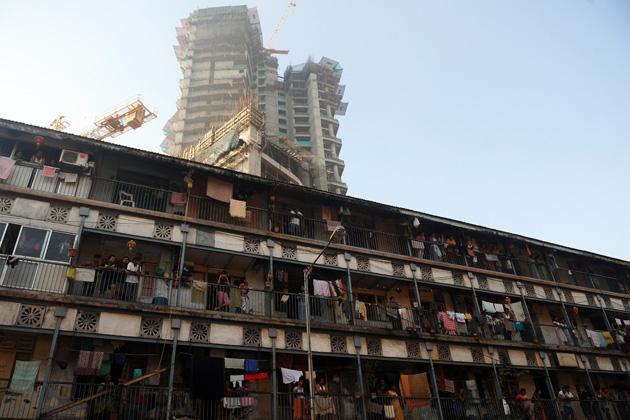July 7, 2012
Thousands of rent-controlled tenants in Mumbai paying $20 a month, and often less, are being turned into millionaires by developers tearing down crumbling colonial mansions to build luxury towers for the rich.

July 7, 2012
Thousands of rent-controlled tenants in Mumbai paying $20 a month, and often less, are being turned into millionaires by developers tearing down crumbling colonial mansions to build luxury towers for the rich.

South Mumbai, including a stretch of prime land hugging the Arabian Sea, has about 500 dilapidated stone structures dating back to the early 1900s with a potential redeveloped value of about $40 billion, according to Pujit Agarwal, managing director at Orbit Corp. (ORB), a Mumbai-based developer that derives about 80 percent of its revenue from redeveloping old buildings.
“For generations, most tenants were living a hand-to-mouth existence, barely making two ends meet,” said Agarwal, whose firm is one of around 75 vying to oust Mumbai’s rent-controlled residents. “Now, with redevelopment, these tenants have become multimillionaires overnight as capital values of the properties they occupied soared.”
Home prices in Mumbai have climbed to a record 10,833 rupees ($200) per square foot, doubling in three years, according to Liases Foras Real Estate Rating & Research Pvt, a research company based in the city.
Sticking it out for the money comes at a price. Mea Kadwani, 78, survived a roof crashing in on his head when part of the three-story building in the upscale Nepeansea Road area, where he has lived since he was a toddler, collapsed. He wasn’t hurt beyond needing a tetanus shot, he said. Still, he and his wife pocketed $2.5 million after three years of negotiations and decades of paying rent that remained below $20 and peaked at $23 a month in a neighborhood where rents typically top $2,000.
Highest Compensation
“Unlike in the U.S., where people change houses an average eight times, here we are very emotionally attached to our homes,” the bespectacled, white-mustachioed Kadwani said while sipping tea in his relocated residence a few blocks from an Aston-Martin dealership. “Very often, we won’t change residence for three generations or more.”
Only 37 percent of Americans have lived in their homes for more than 10 years, with a median duration of 5.9 years, according to U.S. Census Bureau data.
Kadwani received among the highest compensation given by Orbit to nine tenants in Mukund Mansion, built in 1923, which it plans to turn into a garage to accommodate cars for residents of its adjoining 29-story Villa Orb Annex tower currently under construction. Villa Orb’s 7,700-square-foot (715-square-meter), five-bedroom units are selling for about $12 million, Agarwal said, netting the developer around four times the value of the investment after paying 1 billion rupees to the landlords, 750 million rupees to the tenants, and paying for development.
While half of Mumbai’s 18 million residents live in slums, they don’t get comparable payouts when developers come in. Under a government plan, they are instead able to obtain free housing. Developers must provide slum dwellers at least 269 square feet on plots on which they erect buildings.
Nightmare Tenants
The nine-decade-old mansion is one of many such structures in disrepair, as landlords can’t afford to maintain them on the rock-bottom rents they receive and often shell out more than what they collect on property taxes and repairs. Unable to evict tenants because of Mumbai’s rent-control laws, they are left to watch as market prices soar and their asset values sink — and sometimes their tenants profit from the spread on subletting to others.
“It’s been a nightmare dealing with tenants,” said Kiran Bhammer, a 59-year-old diamond jewelry designer who with his family collected rents at Mukund Mansion ranging from $10 to $25 from nine tenants for decades after their parents bought it in 1963. “I’ve had cases where a tenant would illegally sublet the apartment, and the person would refuse to leave until I took him to court to evict him.”
Bodily Harm
Bhammer recalls threats of bodily harm when he’s tried to get those subletting to move out.
“Despite all the problems we faced and the threats we received, I couldn’t leave an asset like that,” Bhammer said. “I even suggested to my wife and kids to move to another apartment until this was resolved, but they refused and decided to stick it out with me.”
Kadwani, the tenant, sympathizes with his rent collector and doesn’t blame him for letting the roof fall in.
“The landlord was in a pitiable condition,” he said. “We didn’t expect him to do much for the building given the rents we were paying him.”
The Bombay Rent Control Act of 1947 was introduced to provide relief to the city’s migrants after the partition of colonial India. Rents were set at 1940 levels to prevent owners from charging excessive rates during a time of distress.
In Mumbai, the measures have been amended and the act rechristened the Maharashtra Rent Control Bill, which allows for a 5 percent annual rent increase. The controls have proved so politically popular that they’ve been extended several times, Orbit’s Agarwal said.
N.Y. Lawsuit
The sagas of rent-control are familiar in New York City, where a post-World War I housing shortage prompted temporary rules that were later upheld and extended after World War II, through the 1960s and into the present day.
A lawsuit by landlord James Harmon against the city was rejected in April by the U.S. Supreme Court, which refused to hear the challenge and left intact rules capping prices on almost a million units in a city where rents averaged $3,418 in March. Harmon, who lives in his brownstone home on Manhattan’s Upper West Side along with six tenants, said half of his renters pay $1,000 a month for one-bedroom apartments.
Courtesy: Businessweek

















































































































